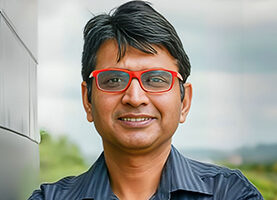
Support Us
Donations will be tax deductible
Trent Northen studies the chemistry of microbiomes. More specifically, he studies how exogenous metabolites structure a microbial community, and, in turn, how those microbes change the metabolite pool and grow the microbial population. Because his work is primarily funded by the Department of Energy, he’s focused on the microbial community in soil and on plant roots.
He describes
Trent Northen is the Interim Deputy of the EGSB Division and a Chemist Senior Scientist at the Berkeley Lab of Biosciences. He begins the podcast describing the rich and complex cycles of plant, metabolites, and microbes, noting how plants feed microbes that live in and around their roots and how those microbial populations in turn help the plants with nitrogen-fixing, excluding pathogens, and transporting phosphorous, among other processes.
His work mostly focuses on bacteria that live in close proximity to the roots, but he describes how fungi can interact with plant roots over very large distances. For example, biological soil crusts use fungal hyphae in extraordinary ways. He explains this process and ecology in more detail and then he describes his research into the microbial community attached to the roots of the plants—the rhizosphere.
He also explains the mechanism of soil depletion in big agriculture, how the compost and organic carbon cycle of decaying plant materials is absent from larger farming systems.
Furthermore, he elaborates on ways the work of his lab can and might address such problems as well as studying which plants might grow in low nutrient environments and heal the soil as well as practices for soil carbon restoration and other advances.
For more information, see his lab’s website, northenlab.org, and eco-fab.org.
Available on Apple Podcasts: apple.co/2Os0myK
Richard Jacobs: Hello, this is Richard Jacobs with the Finding Genius Podcast. I have Trent Northen. He’s a senior scientist at Brooklyn Lab in Chemistry. He’s part of what’s called the EGSB Division, which is the acronym I don’t know but we’ll get into that. We’re going to talk about microbial communities. So, Trent, thanks for coming.
Trent Northen: Yes, my pleasure. Thanks for the invitation.
Richard Jacobs: Yes, can you fill out your background just a little bit and tell me a little bit more about yourself and your work?
Trent Northen: Yes. My laboratory really studies the chemistry of microbiomes and we’re particularly interested in how exogenous metabolites, the metabolites of the environment, the structure of the microbial communities, and in turn how those microbes change the metabolite pools. So, it’s kind of this dynamic reciprocity between what’s out in the environment and the communities that are acting upon them.
Richard Jacobs: Where are you studying the microbial communities in our guts or soil and water, I mean where are they?
Trent Northen: Yes. So, this work is primarily funded by the Department of Energy and so it’s focused on studying environmental microbes mostly in soils but also in plant roots or living on plant roots, so we have these key plant-microbe interactions that are very analogous to what you find in the gut microbiome.
Richard Jacobs: What happens in the plant roots, I guess a person that doesn’t know about this would just think, “Okay, the roots take water from the soil, which will find minerals and absorb them, etc.” But what else is going on, how do the microbes interact with the root system?
Trent Northen: Yes, great question. And I think again, it is very analogous to the gut micro-biome where we’ve been learning to seemingly every week, there’s another study telling us how important the gut microbiome is to human health and development, etc. Same thing with plants. Plants have evolved in the context of microbes, microbes were living in the soil before plants colonized land, so it makes sense that they have evolved to take advantage of the microbes to perform a lot of work for them. So, it’s this sort of beautiful relationship where the plants are fixing carbon from the atmosphere and then they feed microbes that live in and around their roots who go out and perform important functions for those plants. And there’s a wide range of functions that they can perform such as fixing nitrogen for the plants, scavenging minerals for the plants, transporting phosphorus excluding pathogens, microbes can even make hormones to help affect the plant’s phenotype to make it better adapted to drought or being able to reach water, etc. I think we’re just sort of scratching the surface on all the things that microbes do for their plant host.
Richard Jacobs: How far away from the root system do you think the microbes act over what distances?
Trent Northen: So, my work has mostly been focused on bacteria and they live very close, in sort of intimate contact with the roots and probably you don’t have super long-range interactions. However, there are also fungi in the soil that are also really key players interacting with the plants and they can interact over very large distances.
One of the systems that I studied before, and I’m still very interested in but before I got into plants, are the systems called Biological Soil Crusts and so these are dominated by the filamentous sign of bacteria that you find out in the deserts, I know you may have been to places like Arches National Park where you see signs that say “Don’t bust the crust”, these are the biological soil crusts.
They are probably what the earth’s surface looked like before plants colonized land and there have been some really fascinating studies there where they looked at the distance that the biocrust can interact with the plants through fungal hyphae and using stable isotopes they will go put a little isotopic tracer out on the biocrust several feet away from a plant and then they detect it in the plant and they’ll put a tracer in the plant and they’ll go out and sample the biocrust and they find that tracer in the biocrust. So, there are definitely longer-range interactions that are happening and I think that’s an exciting area of research.
Richard Jacobs: I know it’s not your area but is a biocrust like a biofilm, is it like a paste with some liquid that makes the soil adhere, and then it’s essentially like a biofilm that uses the soil as the substrate?
Trent Northen: That’s exactly what it is. It’s really an interesting process, so it’s like just imagine the sandy soil and filamentous cyanobacteria, maybe they blow in on a piece of dust, they can start colonizing that sand and they produce these extracellular polysaccharides that act like glue to bind the sand grains together and the cyanobacteria, they make these little sheets that can be millimeters long covered with these polysaccharides and they act kind of like a rope going and attaching to the sand grains and after a period of — it depends on the environment but it could be a few years, you form these thick crusts of cyanobacteria that are all held together by these extracellular polysaccharides and the filaments from the cyanobacteria and they’re colonized by all kinds of other organisms.
And these are really important systems in these arid lands because they hold the soil together and keep it from blowing away and they also can fix a lot of carbon, so it’s a good way to take damaged lands and bring them back into sort of a stable form where you can also capture some carbon and there’s been a lot of great work done in China harnessing these technologies or harnessing these microbes to restore damaged soils and I think that’s just an incredibly exciting area and important area as we think about climate change and desertification and how can we take these really inhospitable environments and then bring them back into ideally lands that you could use productively.
Richard Jacobs: So, what’s your focus? Are you focusing literally on I guess the microbes that you’ve mentioned as a very thin film around roots, like a couple of microns, stick or like how close do they stick to the roots of a plant?
Trent Northen: Yes. We first actually started studying these biocrusts and we studied cyanobacteria that formed the biocrust and we studied the microbes that were actually physically bound to the Cyanos and we studied how the metabolites that the Cyanos are producing select for the microbes that live on them. So then, more recently, we’ve extended this same approach to studying microbes on roots. And here, we’re really studying the ones that are actually attached to the roots including the soil that’s attached to the root, so that’s what we’re calling a Rhizosphere. So, you can imagine if you had a plant growing in a field or in a pot and you were to lift up the plant and kind of shake it a little bit, everything that’s still stuck to the roots would be what we would be calling the Rhizosphere and those would be the microbes that we’re studying.
Richard Jacobs: Okay. I was imagining a root growing through the soil, is there an area where the very tip of the root is where it grows that’s different from the rest of the root, and what do the bacterial look like that ride along with the root tip growing through new soil? Do you think that’s a guiding that happens from the root or the bacteria etc.?
Trent Northen: Yes, that’s a great question super cool because you imagine a root is so huge compared to the size of the bacterium, and the roots, when they’re growing through the soils, are actually moving really fast compared to the rate that a bacteria can move and so how are microbes able to essentially jump on to this train that is going really fast through the soil? And there’s been some simulation work and modeling work to try to figure out how this works.
So, one theory is that a lot of the colonization is coming from the root tip that the microbes are basically — the root tip gets colonized and there are some different cells that live up there on the roots and when we studied where the metabolites are coming out of the roots, most of it is coming from right at the tip of the roots, that would make sense that that’s maybe where the microbes are really concentrated and we’ve done some studies and the microbes actually tend to be enriched at the root tips and so then, the microbes, as the root’s moving through the soil, from that root tip can be kind of flowing down over the root surface but it’s also very likely that microbes that are in the soil directly, as the root ages, can also colonize the root system. So, it’s a really dynamic environment.
You imagine gut soils, which many people consider the most complex biological system on earth because it’s got minerals and 3-dimensional structure and you’ve got all kinds of diverse organisms living there and then you got these roots that are moving through the soil and they’re developing and the plant’s going through a light-dark system and how does that change, which metabolites are going into the soil, it’s really a complex system to study but also really, really important because over 90% of our food comes from plants and so being able to harness these micro-biomes or understand them sufficiently so that we can use microbes for sustainable agriculture or something I’m really interested in is to try to restore soil carbon. We really have a lot of knowledge that we need to gain to be able to predictably harness microbes for some of these applications.
Richard Jacobs: What’s the main trading that goes on, what does the microbes produce? I know it depends on the plants but in general, what does the plant produce for the microbes and the microbes, what are their main jobs fixing to be in a useable form is one?
Trent Northen: Yes, absolutely. So, we’ve been doing a lot of these experiments that we call Exometabolite Profiling Experiments and basically what we do here is we grow plants hydroponically and we collect what’s called the Exudates, the metabolites that are being released from the roots and then we take that mixture of metabolites and we grow microbes in it and then we use mass spectrometry to measure the changes in the media with the colonization by microbes.
And from this, we can determine what they like to eat and what they produce. So, it’s kind of like we’ve set up this buffet with all these different metabolites that are all produced by the plant and then we individually let the microbes go through the line and we see what they take. And we’ve had some surprising results, probably the most surprising one recently is that some of the metabolites that we thought are like Aromatic Compounds that normally we wouldn’t think of as something that microbes would take first from the buffet are actually preferred substrates for the bacteria that become really abundant in the Rhizosphere and some of these same compounds, the phenolic acids, are actually toxic to other bacteria so it gives us this view that maybe the plant is producing specific molecules that can really give the microbes that the plant wants to select for a huge advantage over other competitors, which would make sense.
Obviously, the plants also releasing the sugars and amino acids that basically all the microbes can use but sort of this new finding is that there are some more specific compounds that may give the microbes that are most beneficial for the plant competitive advantage. And then, I guess your second part of the question was about what are all that the microbes do. The ones that we’ve been really focused on are the ones that actually promote plant growth. And we’ve been studying some microbes and mixtures of microbes that can double the size of a plant through mostly unknown mechanisms but certainly, the production of hormones is a part of that.
Richard Jacobs: I mean in soil, the microbes are essential to the plants, micro-biome, that local micro-biome for the roots, right?
Trent Northen: Exactly right. It’s like a gut turned inside out. You gut the soil on the outside and then the tissues on the inside.
Richard Jacobs: So, have you tried to do like metagenomics to see what’s around the roots, and then if you compare that to the same plant in different soils or different conditions, does the micro-biome change pretty much?
Trent Northen: Absolutely. Yes, we’ve done a fair bit of metagenomics both on plants and then in these biocrusts and we see that the community changes dramatically as you get closer to the root and this is, in a large part, due to these metabolites that the plant is releasing into the environment that the microbes right next to the root can benefit from. And we do these metabolite profiling experiments on plants over a number of different conditions and then we also use metagenomics to relate that to changes in the micro-biome. And what we find is that depending on whether it’s light or dark or depending on the nutrients, how much nitrogen and phosphorus is present in the soil, the plant changes the profile of metabolites that it releases, and in-turn we see a big change in the microbiome. And again, some really recent work is that we’ve found that some of these metabolites that we’ve found are preferentially used by the beneficial microbes are more abundant when the plant is stressed. So, it gives us this view that maybe the plant is calling out for its buddies, it’s producing things that will selectively benefit these microbes that can help the plant with say for example nutrient stress.
So, we think it really gives you a clear view of how you might be able to take this knowledge and use it to help more sustainably grow plants for a variety of different reasons. You can select plants that make more of those metabolites and maybe this would better select for microbes that are going to promote the plant growth or promote growth under nutrient-limited environments.
Richard Jacobs: I don’t know if this is a mistake though but I consider soil to be static, I am picturing earth moving through the soil obviously, that’s microscopically moving, I mean I don’t know if I’m right, a static medium, so how do nutrients not deplete very quickly? It seems like there has to be an active transporter of nutrients. I know that oxygen and nitrogen can percolate through the soil but I just don’t see how soil can be effective by being static, there must be some movement of it.
Trent Northen: Wow. And this is a whole world of research in soils. It’s super interesting. You’ll never look at soil again after you start thinking deeply about it. It has …
Richard Jacobs: You should say as if you knew what I knew, you’d soil yourself.
Trent Northen: Yes, exactly. Get out there and explore. If you have to go dig in your soil, you’ll see that it’s not this homogenous thing like sand.
You’ve got all these different sized clumps, which are called peds, and between them, you have pores just like in a circulatory system. You can think of the kind of like arteries. And then within each of those little clods or peds, you have little micro pores kind of like capillaries. And so you do get circulation through preferential flow paths through soils and of course, all these different organisms like earthworms are making new tunnels and changing the structure continuously. So, it’s very, very dynamic.
And you can imagine when it rains, now the water sort of flushes through the system and brings in nutrients, say if it’s an agricultural soil, periodically the farmer tills the soil and puts in hopefully some new organic material and so then microbes can start breaking that down and so you get all of these variables, the weather, rain, mixing of the soils, all of the biological activities. So, it’s actually a really dynamic environment especially in a fertile, fertile soil is going to be a very, very dynamic process.
And this is really an important system in terms of climate change from all of the anthropogenic emissions but half of it goes in the atmosphere, the other half goes into the oceans and is accumulated in the oceans or in the soils and much of our soils have been depleted in soil carbon through sort of our agricultural practices where we don’t tend to put as many organics back on the soil as we remove. So, I think there’s a huge opportunity to try to harness beneficial microbes and plants to sustainably restore soil carbon as a way of pulling carbon out of the atmosphere and enriching these systems that we use for food production and then, production of bioenergy crops and stuff like that. So, it could be the more we learn about the system the more we can really take advantage of it to address some of these huge challenges that we’re facing.
Richard Jacobs: I was thinking if you compare a plant in a hydroponic system to one in soil, especially if it’s a well-mixed hydroponic system that the plant will be able to respond to different stimuli a lot faster because the bacteria in the water and everything is a lot more fluid, it’s moving around more than in soil and in soil, I don’t know, I just have the sense that you have to depend on other factors to get things moved around. Maybe a plant sitting in the soil, the sunlight, and the heat is the main driver of things up and down in the soil column, I don’t know.
Trent Northen: Yes, the hydroponic system, if you manage it just right and you need to be able to get oxygen and all of the nutrients delivered to the plant but if you could do that, yes, it’s a really nice system. The soils, kind of act as a reservoir of nutrients and water for the plant. That’s why you don’t have to water your garden every day. Soils will actually hold it for the plant. But you’re right, transport limitation can be an issue, which is one of the reasons why the plants really need the microbes. There could be phosphorus just a few millimeters away from the root and the plant needs fungi to be able to go over there and reach it and so to explore a bigger area than the plant can on its own. And in a hydroponic cultivation system, you really don’t need that because you’ve got like you said, a well-mixed system so the plant can access those nutrients on its own.
Richard Jacobs: So, what are you trying to understand, again, in regards to the interaction between the plant and the microbes? You said that depending on the stresses the plant goes through, it changes what it makes available to the microbes above and beyond the basics like the sugars and amino acids. I know there are particular soil stresses that you’ve identified or does it not tend to get stressed as much, it’s more static? Like what can happen on the other end that would cause the plant to change?
Trent Northen: The thing that I’m really interested in is trying to understand how microbes can be used to promote plant growth in marginal soils. So, we’ve been losing productive soils at a crazy rate, and with population growth and climate change, we’re really going to have to quickly figure out how to bring those soils back into cultivation. So, in terms of stresses, these are soils that don’t have very much carbon so they don’t retain water very well, they don’t have very much in the way of nitrogen and phosphorus. So, what do you do with these damaged lands, how do you actually use them for the production of things that we need to feed and provide for a growing population?
So, these are the soils that we’ve been studying. And looking at plants that can grow in these low-nutrient environments and how we can ideally breed crops that are better able to take advantage of microbes and maybe you have to add those microbes when you plant the seeds to be able to thrive in these environments.
And the long-term, I’d hope that the goal would be that as these plants are growing, they’re enriching the soil in carbon and other nutrients so that you’re not only pulling carbon out of the atmosphere but you’re making these soils more fertile so they are more productive. So that’s kind of the big vision. But there’s so much we don’t know to be able to do this and one of the big things that my lab has been working on for the last several years has been developing fabricated ecosystems, so we use 3D printing and micro-fabrication to make devices where we can study the mechanistic basis of beneficial plant-microbe interactions within the laboratory and then we collaborate with lots of other people who can do field studies and we can try to link the principles that we find in the lab and the mechanisms we find in the lab to those in the field.
Richard Jacobs: So, when the soil gets depleted, is there an order in which things get depleted?
Trent Northen: Yes. I mean basically whatever is the limiting region is going to be the one that’s kind of like a chemical reaction or something. If it’s a low phosphorus soil, that’s going to be limiting, so everything’s kind of have to be in the right balance. And another big problem out there is that we get all this runoff because of the fertilizer runoffs that go and pollute our waters because there is this huge imbalance, there’s way too much nitrogen or phosphorus compared to what the plant can use. And so being able to use microbes to capture this and make sure that it’s available to the plant and make the whole process more efficient so we don’t have to use so many fertilizers, another really important area of research in studying plant microbiomes.
Richard Jacobs: How’s fertilized applied, is it like sprayed on the surface?
Trent Northen: Yes, generally sprayed on the surface and the plant gets some of it, some of it is retained in the soils but then the rest just kind of rushes down through the soils and out into the rivers and lakes and you get these dead zones and it’s just a really bad thing to be applying so much excess fertilizer. And one reason why we have to apply so much fertilizer is that the soil’s not retaining it as well as they would have traditionally when they had higher carbon content, so the mineral fertilizers will stick to the carbon in the soils and that will help retain it where the microbes and the plant can access it. So, increasing the soil content has the potential to allow us to use less carbon and to use less fertilizer and keep it right around the roots where it can benefit the plant.
Richard Jacobs: If someone only cares about planting a field of corn, they would only care about the plants that they plant and the surrounding soil maybe not as much, why not? I don’t know how, for instance, corn is planted. I don’t know if they’re seeded or if they throw like a small plant in there like a sapling. Why not throw in like a ball of a little bead of fertilizer in each hole? Why not throw in like a small amount of dirt that has plenty of carbon in it like a source of it and nitrogen, a little bit of fertilizer in each hole instead of spraying it on the surface at least to start, why not do that?
Trent Northen: Yes, I think that the idea of basically providing the seeds that you’re planting in the soil with the perfect situation for growth would be a great way to do it. I think let’s say we could come up with a seed coding, which provided the perfect habitat for that growing seedling including the right microbes, the microbes that would keep the pests away, they would provide help the plant deal with stresses, they would promote the growth of the plant, they would help the plant access nutrients that are locked away in the soil. We provide the metabolites for those microbes to eat so that they’d have a competitive advantage over the microbes in the soil. I think that’s kind of the future. The key driver here is economics. We have to figure out how to do it inexpensively enough that it would pay off for a farmer to do this. I think that’s kind of what’s limiting it right now. They can drive a big tractor through and spray their field and the economics work out, they get a big yield but there are environmental consequences to that in terms of the health of their soil and if there are waterways and so longer-term, going to these more precision in agriculture, I think, is really important.
Richard Jacobs: You said that soils can be depleted of carbon but what form is the carbon and how does it get depleted?
Trent Northen: Yes, so what I’m talking about is organic carbon and if you think about kind of the settling of here we are or I’m in the United States and I think about the breadbasket and how the pioneers came in and they drained all these wetlands and had soil that is just almost black from all the carbon that’s in there and that soil was so fertile and just incredibly productive and really didn’t need to add much fertilizer. And the way that we grow crops, most of our crops are grown, is you go in and you cut off the plant and you send it to market. That’s very different from a natural ecosystem where the plant dies and it falls back in the soil and it decomposes and so that enriches the carbon pool. So, in essence, we’re taking all of the stuff off, taking the biomass off of the land each time we harvest, over a time you’re just going to keep removing carbon from the soils as well as all the micronutrients and other things that make those foods really nutritious and help the plants grow too.
So, over time, you deplete the soil carbon and after a long enough period of time, those lands become pretty low fertility, and then they need to be restored. So, it’s said that about half of soil carbon has been lost and I see that as a huge opportunity because if we can come up with sustainable ways to restore a soil carbon, we could be pulling it out of the atmosphere and the soil carbon restoration could be a really powerful and beneficial carbon-sink that we could be taking advantage of but there’s a lot more we need to know about micro-biomes before we’d be able to really do that efficiently.
Richard Jacobs: For given fields, I’m just speculating here, once you harvest corn from a given field, why not try to turn the entire field into a giant compost and then waste you get, organic wastes from other crops or even from that crop, throw them back in the field and compost it until the next time you’re ready to plant?
Trent Northen: Yes, I think that’s what you should do. I mean I dabble in gardening myself and I can just see such a huge difference in parts of my garden where I put a bunch of compost down and it has all the right microbes and the soil is super-healthy, plants just grow like crazy in there and it just works great. Whereas parts of my garden where I just don’t have that much organics, it just doesn’t grow very well and I have to put a lot of fertilizer on there. I think it all comes back to the economics of it. Organic gardening is more expensive and so that’s why we pay more at the grocery store when the farmers are going through all of this composting and everything to sort of naturally adds organics back onto the soils. But I think that there are a lot of benefits for us in terms of sustainability and I know there are some studies on the nutritional content of crops growing in organic soils, I’m not very familiar with that but I would hope that they would have more micronutrients and things like this or at least I would expect that.
So I think there are a lot of benefits, the key is the economics. And there are already companies selling beneficial microbial treatments that you basically go spray on your plants. And I think it somewhere is a several billion dollar a year market and I think this is just a beginning because they generally don’t really understand how those microbial amendments are working and so they don’t necessarily know when they’re going to work, which type of soil, which kind of environment and I think the more that we can understand these microbes and even start moving to where we’re not just adding one microbe but a whole community of microbes, we can get much more benefits this way both in terms of the plant health and the plant gross promotion but also in terms of the soil health.
Richard Jacobs: Maybe the key is for — I don’t know if you only have so much time but if you’re studying a plant and its metabolites etc. while it’s alive, why not also have another experiment going where you chop the plant up, throw it back into the soil and now study the decomposition cycle, the rejuvenation of the soil and then the metabolites and the bacteria and that’s the other part of the picture that’s missing probably?
Trent Northen: Yes, absolutely. And I have been very fortunate to work on a project led by Mary Firestone that you see Berkley where it was called Cradle the Grave, so it was studying plant growth all the way from the whole carbon cycle all the way from the beginning, little seedling all the way to the decomposition of the plant. And you’re right. If you can understand that whole process, you could predict which microbes and which plants are going to best accumulate carbon within the soils and it’s a whole different micro-biome. The micro-biome that’s living off of what the plant is exuding into the soil is different from the one that’s decomposing the plant biomass, the plant litter. And there are scientists working on it basically all aspects of this. And the key is to kind of bring it all together into sort of integrated understanding and then work with farmers and other stakeholders to transfer it into their hands where that could actually be applied.
Richard Jacobs: Yes, if you don’t understand the decomposition cycle and you don’t bother to have one, then, of course, you have to bring in stuff from the outside.
Trent Northen: Absolutely. But what we’ve generally been doing since the green revolution is we just keep dumping more and more fertilizer on there. And I think that that’s becoming expensive and then it’s causing all kinds of environmental problems and so being able to do less of that and depend more on really targeted amendments including the microbes, I mean there are people out there that are testing the hypothesis that some of the really important microbes have been lost from the soils and so even if you go plant your crop there in the soil, it’s not going to thrive because its buddies are missing. I don’t know if that’s been shown yet but that’s kind of a hypothesis that’s out there. And so as soils get depleted, the diversity of organisms goes way down and so I think it makes sense that a lot of the microbes that would normally be benefitting a plant are missing from those soils that are so different from their natural environments. If you think about corn, corn was adapted from Teosinte and I don’t know much about the ecology of Teosinte but I imagine it grows like every other plant in a diverse community of plants and the diverse community of plants is going to support the diversity of microbes. And then if you go from that to a monoculture of corn where you’re not enriching the soil with organics, then it makes sense to me that you would lose some of these microbes that corn needs to thrive. And so you have to supplement that with fertilizer to make up for it.
Richard Jacobs: Are you also trying to create plans that you spike the soil with excess nitrogen and then see what happens to the micro-biome and another one, you do excess phosphorus, another one potassium and play with the high levels etc. to see how the plants and micro-biome respond?
Trent Northen: Yes, exactly. So, Kate Zhalnina in my lab has been doing those kinds of experiments where she takes a marginal soil, so one that ideally the microbe’s going to be enough to get these plants to grow, very damaged soil. And then she, working with other people at UC Berkley, adds in different fertilizers. And then we do metabolomics and metagenomics and we associate the changes in what the plant is releasing into the environment as far as it exudates to the changes and the microbial community and then all of this in the context of the different fertilizer scenarios. And this is where I was kind of telling you earlier that she’s found these beautiful results that these aromatic metabolites that the plant releases to select what we hypothesize are being released by the plant to select for beneficial microbes are much more abundant when the plant doesn’t have any fertilizer. And as you start adding fertilizer, depending on whether it’s phosphorus or nitrogen, the plant stops making these molecules because it probably doesn’t need it and it doesn’t need its buddies as much.
And again, I think this kind of understanding could be used to breed new cultivars that produce these metabolites for use as a combination in marginal soils that are missing these nutrients and I think that’s just a really exciting opportunity for us to help advance sustainable agriculture.
Richard Jacobs: So, what do you see as — that you’re going to be able to figure out in the near term, in the next year or so, anything that’s getting close?
Trent Northen: Yes, so we’re doing experiments now with plant mutants where they’re missing transporters for some of these metabolites and we’ll be able to use these to test the causal link between the production of these metabolites and the enrichment of these beneficial microbes within the Rhizosphere. So, that’ll really enable us to say, “Yes, absolutely. This metabolite that’s secreted by the plant is selecting for its beneficial microbe, here’s the mechanism”.
Another thing that we’re doing with these fabricated ecosystems, which we call EcoFABs is we’re able to image the microbes going on the root surface in the soil and this is going to provide us all kinds of insights into how these microbes are located within the root system. We talked about this early on, you know, where are those microbes and do different microbes colonize different parts of the roots and how does that change over time as the root is developing because the root system is highly dynamic and I think that’s going to be really important to understanding the role of these microbes and how they’re benefiting the plant at different stages of the plant’s growth. So, I think those are some of the really big things that we’re going to be doing. And we’re also doing experiments where we’re adding in some of these metabolites that we hypothesize select for the beneficial microbes and early indications show that when we add those metabolites, the microbial community looks more like arises for your community, so we’ll take a soil community and we add this mixture of metabolites along with the soil extract and the community looks a lot more like a Rhizosphere community. So, we think this is really providing insights into how you could tailor the mixture of metabolites that the plant is producing to select for the community that you want. And I think that’s something that could go together with these microbial amendments that companies are developing to be able to, I hate using the word “engineer” but sort of design custom-micro-biomes for a crop and a soil that is going to provide the most benefit under those environmental conditions.
Richard Jacobs: So, Trent, what’s the best way for people to get in touch and to find out more about your work?
Trent Northen: Well, they can go to northenlab.org or just Google me and you’ll find my email and my phone number and let me know. I’ll be very interested in talking about this. You can also check out the EcoFAB website, which is eco-fab.org, and read more about these laboratory microbiomes that we’re using and devices that we’ve created to study plant-microbe interactions.
Richard Jacobs: Very good, Trent. Thanks for coming on the podcast. I appreciate it.
Trent Northen: It’s my pleasure. Thank you very much for the opportunity.
Podcast: Play in new window | Download | Embed

In this episode, we sit down with Marc Brettler and Amy-Jill “AJ” Levine to discuss the Jewish faith, Rabbinic Literature, the New Testament, Christianity, Anti-Semitism, and more. How… Read More

As businesses emerge from tax season, many ask: How can I maximize profits and minimize taxes for next year? John Scott, an Anders CPAs + Advisors partner, sits… Read More

In this episode, Avi Kumar, the Founder and CEO of KUWARE Inc., joins us to discuss business marketing, growth, and advertising. KUWARE is a marketing and advertising agency… Read More

Something had been brewing for years in the heart of the Nightingale household: a fervent desire to chart a course away from reliance on conventional systems and embrace… Read More

Mark Holtzapple, a chemical engineering professor at Texas A&M University, returns to the podcast to delve into his unique approach to engine efficiency and alternative energy. His passion… Read More







Subscribe to Our Newsletter
Get The Latest Finding Genius Podcast News Delivered To Your Inbox